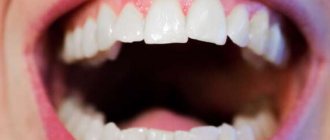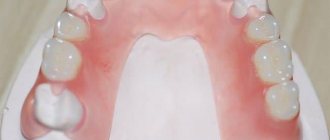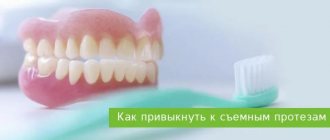Are you worried about the safety of your family budget and at the same time need to install dentures? There are inexpensive but durable orthopedic structures - dentures made of acrylic plastic. Acrylic is a composite, dentures from which are used in cases of complete or partial absence of teeth. A qualified specialist is able to select a model that best matches the shade of the patient’s teeth and gums.
Types of acrylic dentures
Complete removable acrylic dentures are the same “false jaws”. The prosthesis can rest on the gum or be fixed on implants installed for this purpose. Indications for installation:
- complete absence of teeth
- installation of fixed dentures is not possible
Partially removable acrylic dentures are used in the absence of several dental units in a row. They are attached to the supporting teeth using clasps or beam structures. Pre-abutment teeth are ground down or replaced with implants in case of poor condition.
How to quickly get used to removable dentures
Naturally, each person is individual, and the duration of adaptation directly depends on the model and materials of construction. Conventionally, the process of addiction can be divided into three stages:
- irritation stage, which lasts about 7-10 days,
- stage of conditioned inhibition (duration – 3 weeks),
- the stage of full adaptation, when the patient completely gets used to the new artificial teeth (occurs after 30-40 days).
Immediately after installation, removable dentures may cause you nausea, increased salivation, changes or complete loss of taste, and difficulty eating. Diction problems also occur. But as you get used to the design, all manifestations disappear completely or are reduced to a minimum.
“Of course, there are patients who cannot get used to any removable dentures, even if they are made perfectly and in exact accordance with the bite. For example, with an increased gag reflex or if there is initially no psychological mood. In such situations, you need to look for alternatives and the best solution is prosthetics on implants, which is hundreds of times more comfortable and does not cause such unpleasant sensations.”
Chorny Stanislav Vladimirovich, orthopedic dentist, work experience more than 16 years
Can't get used to removable dentures? Dental implantation will solve all your problems. In 1 day and forever. Lifetime guarantee on doctors' work.
Free consultation
During the period of getting used to the prosthesis, you need to wear it constantly, without removing it while eating and sleeping. You should not use it in case of acute pain - it is better to consult a doctor to correct the design.
It is important to understand that any removable denture, especially if it is installed for the first time, will require regular correction. The gums sag along with the bone tissue, the position of the joint changes, the bite is adjusted - all this will lead to the fact that the prosthesis will seem uncomfortable. One visit to the doctor and the position of the device will change - you will become more comfortable. Remember this and do not ignore your doctor's recommendations.
Getting used to the artificial jaw
Before wearing a removable denture becomes comfortable, each patient goes through an adaptation stage.
The orthopedic design is initially perceived as a foreign body, which can affect the patient’s taste and general well-being:
- the perception of temperature and taste characteristics of food changes;
- discomfort, irritation, gag reflex, increased salivation occur;
- the patient may bite his cheeks and tongue;
- there are difficulties in pronunciation and chewing food.
The duration of the adaptation period is individual for each patient. As a rule, after a week the irritation stage passes. Speech with a new prosthesis returns to normal after about 3 weeks, and with constant use, complete adaptation occurs within a month.
How to make it easier to get used to dentures: expert advice
- under the guidance of a dentist, master the skills of independent use of orthodontics (how to put on and take off);
- during the first 2 weeks, try to wear dentures around the clock, removing them only for washing, disinfecting the product and oral hygiene;
- rinse your mouth often with water, drink warm tea;
- use high-quality means for fixing the prosthesis;
- the first few days, give preference to soft foods;
- try to chew slowly, thoroughly, on both sides at once;
- To quickly restore speech, read aloud for 1-2 hours a day, pronounce tongue twisters, talk while holding nuts or candies in your mouth.
How to restore diction
To restore diction, it is recommended to speak as much as possible: read books, pronounce tongue twisters, while holding one or more sweets in your mouth (without sugar! For example, Sula with mint or sea buckthorn).
15-20 minutes, several times a day. The duration of the course is the first 1.5-2 weeks after prosthetics. Tongue twisters for restoring diction after removable prosthetics
| For your convenience, we have selected several useful tongue twisters |
| The snout pig was white-nosed, blunt-nosed; I dug up half the yard with my snout, dug, dug. |
| Karl stole Klara's advertising, and Klara stole Karl's budget. |
| In Kabardino-Balkaria, valocordin from Bulgaria. |
| The fast talker quickly said quickly, That you can’t quickly talk all the tongue twisters, but you can’t over-speak all the tongue twisters, But, having quickly spoken, he quickly said, That you can’t talk all the tongue twisters, but you can’t over-speak. |
How to improve the fixation of removable dentures
The anatomical conditions in the oral cavity do not always allow for the creation of good fixation for removable dentures. This especially applies to prosthetics for the complete absence of teeth in the lower jaw. Under unfavorable conditions, special fixing agents in the form of creams, fixing pads, and powders are used to keep it in the mouth. They are sold under the brands “President”, “Corega”, “Protefix” in any pharmacy.
The fixing cream is applied in a thin broken line to the prosthesis. Before applying the cream, removable dentures must be dried, for example with a cotton swab. Fixing powder is used for low salivation. It is applied in a thin layer to the wet denture, after which the removable dentures can be put on. Your dentist will help you decide on the choice of fixative.
What hygiene products can be used
Hygiene products for the care of removable dentures
| Name | Description |
| Toothbrush | You will need a personal brush with soft bristles; too hard can lead to scratches in which bacteria will accumulate. We recommend the Curaprox brand – brushes with soft or ultra-soft bristles. They do not damage the plastic, but do an excellent job of removing plaque on the teeth, also cleaning it from under the gums. |
| Toothpaste | Low-grade, for example, Parodontax, ROCS To clean the prosthesis itself, you can also use children's paste - it is more gentle. |
| Irrigator | The device is necessary both for cleaning your own teeth, if they remain in the mouth, and for cleaning dentures - it effectively removes plaque and allows you to clean the interdental spaces very efficiently. |
| Citric acid and soda or tablets for cleaning and disinfection | Use for periodic cleaning and disinfection of structures - make solutions for rinsing the mouth or place dentures in them (applies to citric acid and soda). The tablets must be dissolved in water and the resulting solution must be used to soak the structure. |
Advantages and disadvantages
Acrylic dentures have a rigid plastic base, so they are not as flexible as nylon and silicone ones. But they are stronger, retain their shape better, and have a much longer wearing life. Unlike previously used rubber dentures, which were stored only in water, acrylic ones are left in the air after cleaning.
Among the advantages of acrylic prostheses are the ease of their manufacture, attractive appearance, light weight, and the ability to repair the prosthesis if damaged. Another advantage of an acrylic prosthesis is that adjacent living teeth are not ground down to install it. In addition, until the very end of its service it looks like new.
The load when using dentures is distributed on the tissues of the palate, gums and remaining teeth, which prevents tooth decay.
Another advantage is the cost of acrylic dentures. Acrylic dentures have few disadvantages, but among them is a short service life. The prosthesis may not withstand intense loads, and its average service life is much shorter than that of others - 2 - 8 years. Doctors recommend wearing removable acrylic dentures for 3-4 years, however, in the case of an increased rate of bone tissue atrophy, their service life is 2-2.5 years. If the bone tissue atrophies slowly, the service life of the prosthesis increases to 5-8 years.
What to do if the prosthesis rubs and does not fit well
- use ointments (Solcoseryl, Metrogyl Denta) or sea buckthorn oil. Apply the oil to the gums for a maximum of 20 minutes after eating and cleaning the denture 3-4 times a day,
- It is forbidden to sharpen dentures yourself, after which you can simply throw it away,
- If there is acute and constant pain caused by rubbing of the structure, you should consult a doctor for correction. 2-3 hours before the visit, the denture should be in the mouth so that the reason why the structure is rubbing becomes visible.
If the device is not fastened well, then you should contact your attending physician - an orthopedic dentist. If the correction does not help, you will have to use special fixation creams: Protefix, Corega, Lacalut Dent. Choose the one that suits you - according to taste, consistency, fixation time. Try different options and choose the best one.
Types of prostheses
Acrylic dentures come in partial and complete types. Partial teeth are used to replace several nearby lost teeth and are attached to the gum using clasps, metal or plastic. Complete dentures are used when teeth are completely lost. They do not need fastenings and rest only on the gums.
If the prosthesis is made correctly, a discharged space appears between it and the oral cavity (the so-called “closing valve”), and the prosthesis is held in place by suction. It holds better on the upper jaw, worse on the lower jaw.
To improve fixation, use a special glue applied to the surface. You can also install mini-implants that will securely hold the prosthesis, but the cost of such prosthetics increases. If a young patient is missing one or two adjacent teeth, and he does not want to grind down the adjacent ones for crowns or insert implants, he is fitted with a butterfly denture. It is convenient on distant molars, where it is invisible. This prosthesis is designed to be worn permanently.
How to eat after installing structures
If the prosthesis is made of comfortable materials, if it suits you, then you will be able to eat well right away. Restrictions occur when little time has passed after the removal of living teeth, when you initially had gum inflammation. In such situations, pressure causes pain; you need to limit the chewing load to avoid discomfort and allow the gums to recover.
In general, during adaptation it is advisable to adhere to the following recommendations:
- give preference to soft and warm foods, exclude viscous foods,
- you need to chew carefully and thoroughly, cut food into small pieces,
- It is better to chew food on the side where the process does not cause pain,
- You should refrain from biting food with your front teeth.
After adaptation, when the prosthesis no longer causes pain, you can return to your usual diet. But you should exclude foods that are too hard, viscous, sticky, excessively hot and cold (drinks and soups should be warm, ice cream should be kept a little at room temperature).
Nylon dentures
When choosing a removable denture, your doctor will offer you several options for materials. It can be nylon, acrylic or silicone. Nylon is a durable and elastic material. Due to these properties, removable dentures made from this material are called “flexible”.
Nylon prostheses have a number of undeniable advantages:
- Hypoallergenic;
- Durable;
- Easy to use;
- The fastening is reliable;
- Does not require grinding of adjacent teeth or other painful procedures;
- Will not break diction;
- Suitable for people suffering from diabetes and heart disease;
- You can choose any crown material.
One of the biggest advantages of nylon backing is its long lifespan and ease of maintenance. You can clean nylon removable structures with regular soap and a brush. However, to extend the life of the dentures, you should still use special baths and pastes. Once every two to three months, it is advisable to take nylon dentures to the clinic so that they can be more thoroughly cleaned.
Another advantage is that any crowns can be selected for nylon removable structures, which means this technology is available to patients with different financial capabilities.
How to clean dentures and remaining teeth
You need to brush your teeth exactly as you are used to: in the morning, in the evening and after every meal. But as for prosthetics, the recommendations will be as follows:
Daily care
- clean the structure in the morning and evening with a soft toothbrush using toothpaste without abrasives or regular soap (preferably baby soap). Pay special attention to the internal area that is in contact with the gum,
- Soak the denture daily in a solution of citric acid (1 teaspoon per 150 ml of warm water): soak it for 10 minutes to disinfect and loosen plaque. Carry out the procedure before brushing your teeth 2 times a day. Afterwards, rinse thoroughly with water. Change the solution every 3-5 days,
- after each meal, the structure is removed and thoroughly rinsed under running water,
- Additionally, you can use an irrigator, which will clean the microscopic gaps between the crowns of the structure,
- Be careful when brushing your teeth, especially if there are small parts - hooks, clasps, so as not to damage them.
Periodic care
- soak in a disinfectant solution - for this you need to purchase special tablets for removable dentures (Protefix, Corega, Lacalut Dent). Use up to 3 times a week while maintaining daily hygiene. Use according to instructions (keep in solution for 15-20 minutes),
- use products that suppress the activity of oral microflora (especially important several years after the installation of dentures, since more plaque accumulates on them). For example, “Tantum Verde” (spray, lozenges) - relieve inflammation and tension, freshen breath.
Modern equipment - ultrasonic sterilizers - can be used to disinfect dentures. They allow you to achieve ideal cleanliness of artificial teeth at home, cleaning them from bacteria and plaque. These devices can also be used to disinfect any other items - toothbrushes, baby bottles, etc.
Clasp dentures
Partially removable clasp structures are made from different materials. The most commonly used materials are cermets and plastics. Depending on the type of material, it is determined what the optimal care for clasp dentures will be.
The peculiarity of caring for them is explained by the fact that their arches are made of metal. This requires a special approach to cleaning. When an arc is made of several separate parts, the joints should not be mechanically processed to avoid darkening and staining on them. When cleaning, only use a soft brush. Otherwise, care is similar to that of other removable models. Only once a week you need to treat them in a biological solution designed to remove stubborn stains and food debris.
If home care does not give the desired effect, then professional cleaning is recommended to remove hard deposits and plaque. This needs to be done once every six months.
It is not necessary to remove the clasp structures at night, especially during the first 2 weeks.
Do I need to remove dentures at night?
Modern “removers” can be worn constantly and it is not necessary to remove them at night – especially during the first 2-3 weeks, while adaptation to the designs occurs. However, outside the oral cavity, dentures with a plastic base should NOT be placed in a humid environment, since favorable conditions are created for the development and growth of pathogenic microflora. This can lead to bleeding and gum inflammation.
If there are metal elements, the prosthesis must also not be stored in tap water, especially chlorinated water - this can lead to metal corrosion.
For storage and transportation, it is necessary to use specially designed protective ventilated boxes/cases in which the prosthesis will be kept clean and dry.
Give up removable dentures forever! Consultation + diagnosis + treatment plan FREE. Find out which dental implantation method is right for you in 1 day!
Enroll now
Stages of installing an acrylic prosthesis
The process of creating prosthetic devices from acrylic involves several stages:
- Initial visit to a specialist. During this process, the doctor examines the condition of the supporting teeth and makes an impression of the maxillary and mandibular sections.
- Making a plaster model of the jaw in the laboratory. To do this, the dental technician uses a previously created impression. Also at this stage, wax ridges (bite templates) are produced, the width of which corresponds to the dentition.
- Second visit to a specialist. In this step, wax templates are inserted into the patient's mouth and the patient is asked to close their jaws tightly. This allows you to determine the existing displacements and characteristics of the bite.
- The resulting blanks are returned to the laboratory center to create a wax model. Next, the design is tried on. This is the longest period, which requires the highest professional skills from the dental technician. Its duration can reach 3 days.
- Adjustment of the wax model, elimination of deficiencies.
- Production of prosthesis from acrylic material. The duration of this process is 1 day.
- Primary fixation of the finished structure, identification of shortcomings, adjustments - if necessary.
- Making an acrylic prosthetic device.
In general, the entire process of creating acrylic prostheses requires about 10-12 days - if no significant errors were identified during the initial fitting. To correct identified deficiencies, a dental technician needs at least 7 days.
Elident dentistry employs highly qualified prosthetists and professional dental technicians, and also uses innovative equipment, which eliminates the possibility of serious errors in the manufacture of acrylic devices and allows for a shorter treatment period.
Is it possible to whiten dentures?
If hygiene is insufficient, dentures may change their shade. But, unfortunately, it is impossible to bleach it to its original state, especially if a lot of plaque has accumulated and the coloring pigments have penetrated deep into the pores of the material. The doctor can perform polishing - the prosthesis will be smoother, its top layer will be a little ground off, so the structure will be visually lighter. At home, you can try using special whitening tablets (for example, Corega), but you should not overuse them - they can damage the prosthesis materials.
How to care for removable dentures
Proper care of them is of great importance for the period of adaptation (adaptation) and the service life of prostheses. Removable dentures require regular cleaning. The best option is to clean dentures daily after each meal under running water. The obligatory minimum is cleaning the prosthesis before going to bed. The main criterion is that the prosthesis must be as clean as on the first day. The cleaner the denture, the more comfortable you will feel it in your mouth.
When cleaning a denture with whitening toothpaste, scratches may form on it, which contributes to the rapid accumulation of plaque on the denture, because Such pastes contain abrasive substances, so for daily care you can use a weak soap solution.
Dirty removable dentures cause rapid wear and tear and inflammation in the oral cavity. If there is inflammation of the mucous membrane in places of contact with a removable denture, pain, or burning, you should immediately consult a doctor. From strong tea, coffee and smoking, removable dentures lose their appearance, turn yellow, and a brown coating appears on them. With good care, removable dentures retain their color and shine for a long time.
An indicator of good care is the absence of food and plaque on the prosthesis. To remove age spots from coffee and nicotine, etc., which may appear over time, you should consult a doctor. The dental technician will restore the necessary polish and shine.
To clean dentures, you can use special cleaning agents sold in pharmacies (President, Corega, Protefix). They also help get rid of plaque and destroy bacteria that cause bad breath. The prosthesis is placed in a glass of clean water and a tablet is lowered; the prosthesis is kept in the solution for a certain time recommended by the manufacturer.
How to know when it’s time to change your dentures
It is recommended to change dentures every 3-5 years or 5-7 years (depending on the material and type of construction).
When using removable dentures, the load from chewing food on bone tissue is only insignificant, which is fraught with its gradual resorption. The jawbone decreases in size, and not always evenly. This process takes from six months to several years and leads to a discrepancy between the shape of the prosthesis and the relief of the gums - the prosthesis is less secure and becomes less stable. This means relocation (if possible) or complete replacement of the structure is required.
In addition, materials wear out over time under the influence of saliva, nicotine, food irritants, and mechanical stress. Cracks appear on the structure, the surface becomes less smooth, which contributes to the accumulation of a large amount of plaque. If you have chosen crowns made of plastic (namely, they are in most cases used in removable orthopedic devices), it is worth considering that they wear down quite quickly, so after about 2-3 years the bite changes, which can affect the condition of the joint and the process of normal chewing food.
Contraindications for the use of acrylic dentures
Acrylic dentures, as reviews indicate, are not recommended for use in the following situations:
- If there is a possibility of allergic reactions to the material from which the prosthetic structure is made. Primary signs of incompatibility are indicated by discomfort or redness in the area of the installed prosthesis;
- Presence of a gag reflex. This creates difficulties not only during fixation of the structure, but also during its further operation;
- Destruction of bone tissue. Atrophic processes make the jaw bone flat, which eliminates the possibility of using a prosthetic device. It is not possible to hold the structure on the jaw even if special strengthening agents are used.
Repair and correction of defects
Many patients are very interested in this particular question, because dentures are not cheap. Repairing removable structures is quite possible if the crowns, that is, artificial teeth, are damaged.
If damage occurs on the base, then unfortunately the entire prosthesis will have to be replaced. Minor imperfections that appear on crowns can be corrected using special materials. The base is made as one piece at a time. If a removable denture breaks, it will have to be replaced with a new one.











